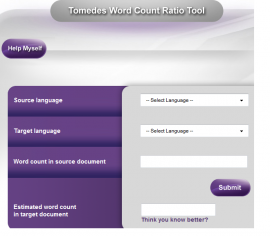
Competition within the translation community, just as with many other freelance industries, can be extremely high. The use of the internet and the growth of remote working have changed the face of the translation industry dramatically within the past two decades, with the result that a recent survey on a ProZ.com forum found that between 45% and 50% of translators class competition within the industry as ‘fierce.’ The global economic crisis has exacerbated the situation, with budgets slashed in many industries that traditionally require translation services.
Now, through the use of a new, free translation tool designed to allow translators to calculate a target document word count accurately, this diverse and competitive sector is pulling together for the common good. Though the underlying competition remains in place, a crowd sourcing approach is highlighting one area where translators from across the world are working together to improve the sector as a whole.
- What it is: the item in question is the online word count ratio tool, which was developed and launched by translation company Tomedes in June 2013.
- What it does: the tool works by allowing translators to turn the word count of their source document into a word count for their target document.
- Why it’s important: the tool enables translators to calculate their rates more accurately and effectively based on the target document word count – something which should serve to make every translator’s life easier.
- How it works: the tool works based on data entered by those using it, taking an innovative, crowd sourcing approach to enable its continual development. Translators use their personal experience in order to contribute to the tool’s accuracy – the more data that is entered, the more accurate it becomes.
Until the development of the word count ratio tool, calculating the word count of a target document was a largely speculative practice. Tomedes developed the tool as a result of their own daily need to calculate word count ratios. The company is not in the habit of creating products, but a fruitless search for this much-needed tool inspired the team to create something that would improve their own working lives at the same time as benefiting the entire translation community.
Having been successfully trialled over the last few months, the word count ratio tool is now ready to start benefiting translators on a global scale. Many of those testing it found that using the tool quickly became an essential part of their daily working routine, and now that the initial bank of data has been built up, the tool is ready to be shared worldwide.
At no cost to those using it, and with the clear benefit of allowing the more accurate calculation of rates based on target document word count, it’s easy to see why the pilot of the tool has been so well received. Now being actively shared with the wider community, the word count ratio tool is expected to take off in a big way.
Try it at http://www.tomedes.com/word-count-ratio-tool and leave a comment to let us know what you think.
Author bio
 Gal Nissani is the Marketing Manager of Tomedes, a leading global translation company, with thousands of professional linguists and translators across the globe. It provides translation and localization services to major Fortune 500 companies, international enterprises and small businesses alike. You can find Tomedes on Twitter, Facebook, Linkedin and Google+.
Gal Nissani is the Marketing Manager of Tomedes, a leading global translation company, with thousands of professional linguists and translators across the globe. It provides translation and localization services to major Fortune 500 companies, international enterprises and small businesses alike. You can find Tomedes on Twitter, Facebook, Linkedin and Google+.








Well, I tried it and for a source doc in US English of 6333 words, the tool estimated some 7500 something words for the target in Lat-Am Spanish, while the actual figure was in fact 6733. I provided this figure and it went into the tool’s database, so to speak.
I believe that this is still in a sort of beta stage and that it will – as stated in the blog post – become more accurate as feedback from users keeps being fed into the system.
Hi Nelida,
I’m Sorry to hear the tool’s estimation didn’t suit the ratio you know from personal experience. Your conclusion was just right – The tool does need as many information as possible to get more and more accurate, and unfortunately the mentioned language pair doesn’t have as many data as other language pairs. Most importantly – Thank you for contributing 🙂
You are welcome, Gal! Have a splendid weekend!